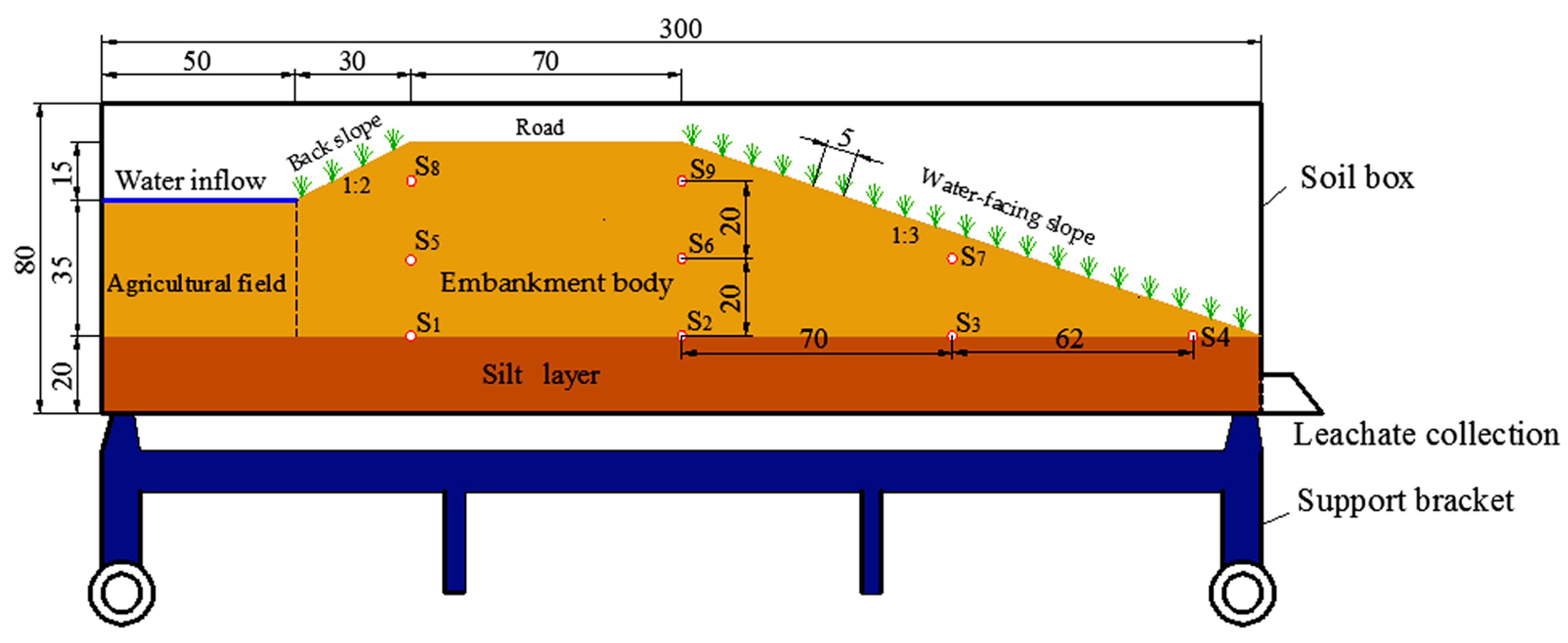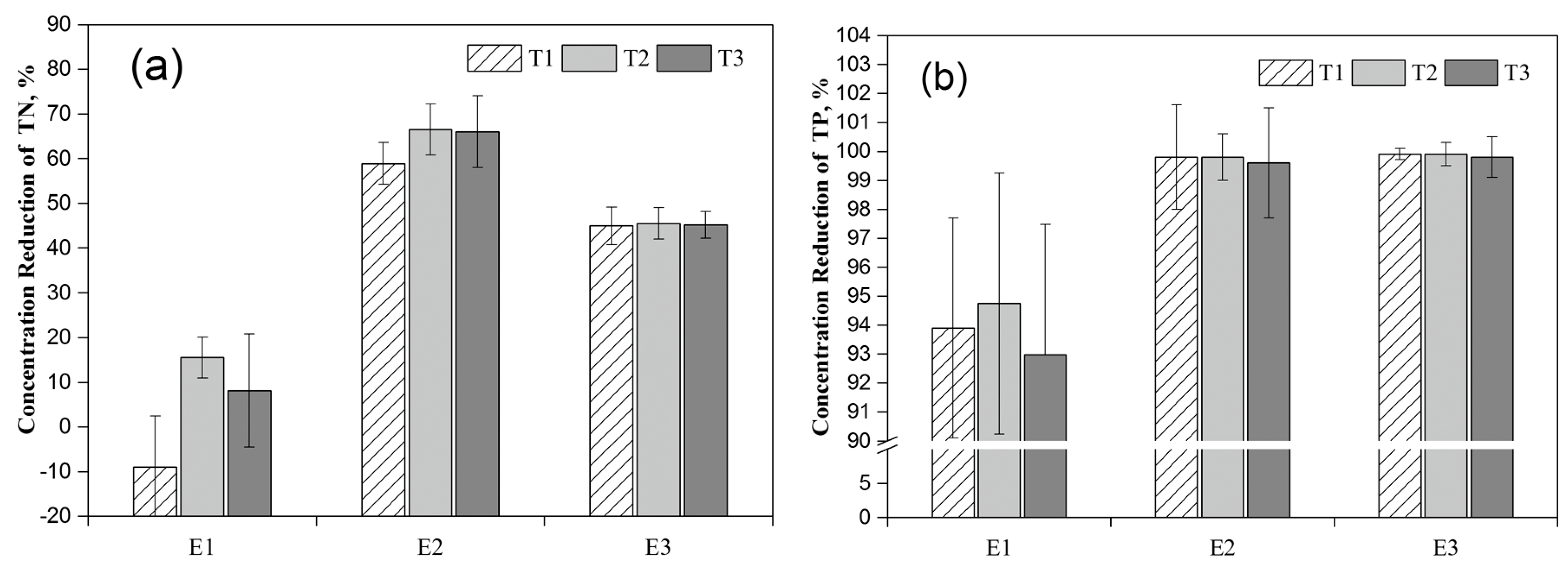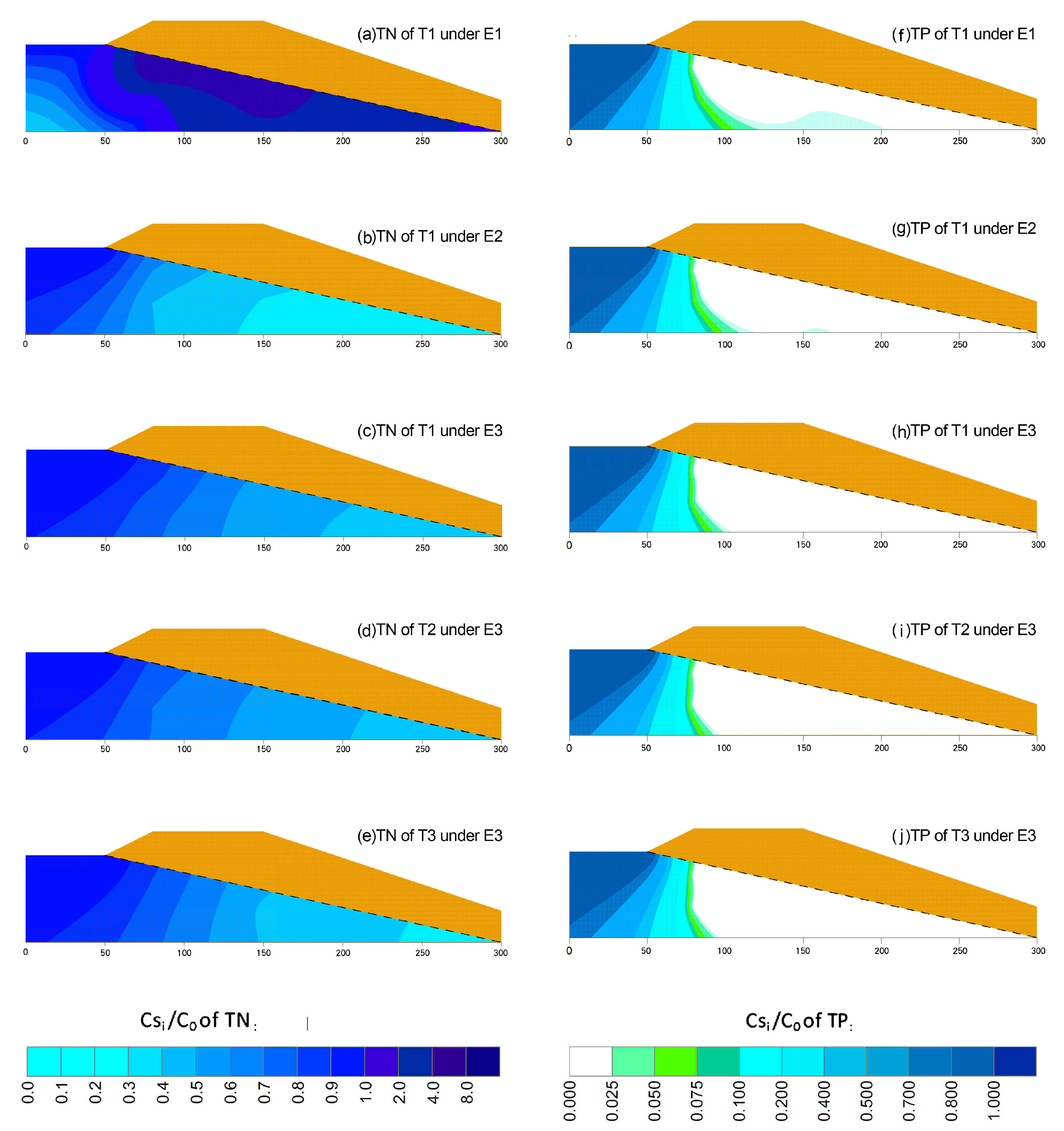The Impact of Vegetative Slope on Water Flow and Pollutant Transport through Embankments
Abstract
:1. Introduction
2. Material and Methods
2.1. Experimental Design and Materials
2.2. Simulating the Inflow Process
2.3. Samples and Analysis
3. Results
3.1. Water Flux
3.2. Pollutant Reduction
3.2.1. Pollutant Concentration of Leachate from the Embankments
3.2.2. Pollutant Removal through the Embankments
3.3. Pollutant Transport Distribution in the Embankment
4. Discussions
4.1. Impact of Vegetative Slope on Water Flux
4.2. Impact of Vegetation Slope on Pollutant Transport
5. Conclusions
Acknowledgments
Author Contributions
Conflicts of Interest
References
- Duchemin, M.; Hogue, R. Reduction in agricultural non-point source pollution in the first year following establishment of an integrated grass/tree filter strip system in southern quebec(canada). Agric. Ecosyst. Environ. 2009, 131, 85–97. [Google Scholar] [CrossRef]
- Kong, L.; Zhang, Z.; Zhu, L. Review of the trends in the study of non-point source nitrogen in hydrological processes on farmland over irrigation district. Adv. Water Sci. 2010, 21, 853–860. [Google Scholar]
- Maruani, T.; Amit-Cohen, I. The effectiveness of the protection of riparian landscapes in israel. Land Use Policy 2009, 26, 911–918. [Google Scholar] [CrossRef]
- Howarth, R.; Chan, F.; Conley, D.J.; Garnier, J.; Doney, S.C.; Marino, R.; Billen, G. Coupled biogeochemical cycles: Eutrophication and hypoxia in temperate estuaries and coastal marine ecosystems. Front. Ecol. Environ. 2011, 9, 18–26. [Google Scholar] [CrossRef]
- Xia, J.; Yan, Z. Advances in research of ecological riparian zones and its trend of development. J. Hohai Univ. Nat. Sci. 2004, 32, 252–255. [Google Scholar]
- Lee, K.H.; Isenhart, T.M.; Schultz, R.C. Sediment and nutrient removal in an established multi-species riparian buffer. J. Soil Water Conserv. 2003, 58, 1–8. [Google Scholar]
- Schneider, R.L.; Negley, T.L.; Wafer, C. Factors influencing groundwater seepage in a large, mesotrophic lake in new york. J. Hydrol. 2005, 310, 1–16. [Google Scholar] [CrossRef]
- Shaw, B.R.; Radler, B.T.; Haack, J. Exploring the utility of the stages of change model to promote natural shorelines. Lake Reserv. Manag. 2011, 27, 310–320. [Google Scholar] [CrossRef]
- Li, M.H.; Eddleman, K.E. Biotechnical engineering as an alternative to traditional engineering methods—A biotechnical streambank stabilization design approach. Landsc. Urban Plan. 2002, 60, 225–242. [Google Scholar] [CrossRef]
- Li, X.P.; Zhang, L.Q.; Zhang, Z. Soil bioengineering and the ecological restoration of riverbanks at the airport town, Shanghai, China. Ecol. Eng. 2006, 26, 304–314. [Google Scholar] [CrossRef]
- Xinjun, W.; Jirun, L.U.O. A preliminary study of ecological embankment construction for urban river restoration. J. Fudan Univ. Nat. Sci. 2006, 45, 120–126. [Google Scholar]
- Fernandes, J.P.; Guiomar, N. Simulating the stabilization effect of soil bioengineering interventions in mediterranean environments using limit equilibrium stability models and combinations of plant species. Ecol. Eng. 2016, 88, 122–142. [Google Scholar] [CrossRef]
- Ostendorp, W. New approaches to integrated quality assessment of lakeshores. Limnologica 2004, 34, 160–166. [Google Scholar] [CrossRef]
- Xia, J.; Lin, L.; Lin, J.; Nehal, L. Development of a gis-based decision support system for diagnosis of river system health and restoration. Water 2014, 6, 3136–3151. [Google Scholar] [CrossRef]
- Jing, C.A.I.; Xiaoping, L.I.; Xiaohua, C. The effects of ecological riverbank slopes on surface runoff pollution control. Acta Sci. Circumst. 2008, 28, 1326–1334. [Google Scholar]
- Wu, Y.; Lu, X.; Zhong, Z.; Shi, J.; Xu, W. Influencing factors of nitrogen removal from stream water using special riverine ecosystem. J. Cent. South Univ. Sci. Technol. 2011, 42, 539–545. [Google Scholar]
- Gou, W.; Bai, S.; Zhang, X.; Gan, Y. Progress of centipedegrass on genetic diversity and application. Grassl. China 2002, 24, 48–53. [Google Scholar]
- Shiono, T.; Haraguchi, N.; Miyamoto, K.; Shinogi, Y.; Miyamoto, T.; Kameyama, K. Evaluation of strips of centipede grass for sediment load reduction. Water Sci. Technol. 2008, 58, 2347–2352. [Google Scholar] [CrossRef] [PubMed]
- Xu, S.; Li, J.; Zhao, D. Research advances in physiological ecological and biochemical characteristics of festuca arundinacea. Acta Prataculturae Sin. 2004, 13, 58–64. [Google Scholar]
- Li, G.; Liu, X.; Han, M.; Hou, L.; Sang, N. Selecting tolerant grass seedlings and analyzing the possibility for using aged refuse as sward soil. Ecotoxicol. Environ. Saf. 2010, 73, 620–625. [Google Scholar] [CrossRef] [PubMed]
- Zhang, Z.-Y.; Kong, L.-L.; Zhu, L.; Mwiya, R.M. Effect of drainage ditch layout on nitrogen loss by runoff from an agricultural watershed. Pedosphere 2013, 23, 256–264. [Google Scholar] [CrossRef]
- Zhang, Z.; Feng, G.; Kong, L.; Bakhtawar, W. Effect of irrigation methods on nitrogen and phosphorus loss by runoff in paddy field through ephemeral storm process. Fresenius Environ. Bull. 2016, 25, 3484–3492. [Google Scholar]
- Teng, C.; Wang, T.Q. SPSS Statistical Analysis, 8th ed.; Wuhan University Press: Wuhan, China, 2014; pp. 182–183. [Google Scholar]
- Lee, T.M. Effects of nearshore recharge on groundwater interactions with a lake in mantled karst terrain. Water Resour. Res. 2000, 36, 2167–2182. [Google Scholar] [CrossRef]
- Genereux, D.; Bandopadhyay, I. Numerical investigation of lake bed seepage patterns: Effects of porous medium and lake properties. J. Hydrol. 2001, 241, 286–303. [Google Scholar] [CrossRef]
- Zhao, B.; Chen, Z.; Hu, L.; Zhang, F. Turfgrass evapotranspiration: A review. Acta Ecol. Sin. 2003, 23, 148–157. [Google Scholar]
- Zhao, W.; Ma, H.; Yu, W.; Dou, P. Effect of different mulching modes on soil moisture evaporation. J. Drain. Irrig. Mach. Eng. 2016, 34, 539–544. [Google Scholar]
- Yang, J.; Mo, M.; Song, Y.; Chen, X. Hydro-ecological effects of citrus land under vegetation measures of soil and water conservation in red-soil slope. Resour. Environ. Yangtze Basin 2012, 21, 994–999. [Google Scholar]
- Mayer, P.M.; Reynolds, S.K., Jr.; McCutchen, M.D.; Canfield, T.J. Meta-analysis of nitrogen removal in riparian buffers. J. Environ. Qual. 2007, 36, 1172–1180. [Google Scholar] [CrossRef] [PubMed]
- Morel, C.; Tunney, P.; Plenet, D.; Pellerin, S. Transfer of phosphate ions between soil and solution: Perspectives in soil testing. J. Environ. Qual. 2000, 29, 50–59. [Google Scholar] [CrossRef]
- Li, Y.; Simunek, J.; Zhang, Z.; Huang, M.; Ni, L.; Zhu, L.; Hua, J.; Chen, Y. Water flow and nitrate transport through a lakeshore with different revetment materials. J. Hydrol. 2015, 520, 123–133. [Google Scholar] [CrossRef]
- Tang, H.; Huang, S.F.; Wang, M.; Zhou, H.Y.; Chen, H.J. Removal of runoff pollution by different grass-buffers. Enuivon. Sci. Technol. 2009, 32, 109–112. [Google Scholar]
- Zaimes, G.N.; Schultz, R.C.; Isenhart, T.M. Total phosphorus concentrations and compaction in riparian areas under different riparian land-uses of iowa. Agric. Ecosyst. Environ. 2008, 127, 22–30. [Google Scholar] [CrossRef]
- Dorioz, J.M.; Wang, D.; Poulenard, J.; Trevisan, D. The effect of grass buffer strips on phosphorus dynamics—A critical review and synthesis as a basis for application in agricultural landscapes in france. Agric. Ecosyst. Environ. 2006, 117, 4–21. [Google Scholar] [CrossRef]
- Schroeder, P.D.; Kovar, J.L. Comparison of the phosphorus sorption characteristics of a conservation reserve buffer and an adjacent crop field. Commun. Soil Sci. Plant Anal. 2008, 39, 2961–2970. [Google Scholar] [CrossRef]




| Characteristics | Mean | SD |
|---|---|---|
| Soil particle size distribution (%) | ||
| Sand (0.05–2 mm) | 14.8 | 0.2 |
| Silt (0.002–0.05 mm) | 59.0 | 2.8 |
| Clay (0–0.002 mm) | 26.2 | 1.8 |
| Initial content of (mg·kg−1) | ||
| Total phosphorus | 148.6 | 33.1 |
| Total nitrogen | 334.6 | 74.5 |
| Saturated hydraulic conductivity (cm·min−1) | ||
| Subject layer of 1.30 g·cm−3 | 0.208 | 0.068 |
| Silt layer of 1.40 g·cm−3 | 0.061 | 0.002 |
| Code | Description |
|---|---|
| T1 | simulated riparian bank with bare slope |
| T2 | simulated riparian bank with slope covered by centipede grass, about 95% coverage finally |
| T3 | simulated riparian bank with slope covered by tall fescue grass, about 70% coverage finally |
| E1 | inflow event 1 with pollute water of 2.0 mg·L−1 TN and 0.4 mg·L−1 TP |
| E2 | inflow event 2 with pollute water of 10.0 mg·L−1 TN and 2.0 mg·L−1 TP |
| E3 | inflow event 3 with pollute water of 20.0 mg·L−1 TN and 4.0 mg·L−1 TP |
| Event | T1 | T2 | T3 | |||
|---|---|---|---|---|---|---|
| LV 1 (L) | (%) | LV (L) | (%) | LV (L) | (%) | |
| E1 | 390 | 78.0 | 412 | 82.4 | 405 | 81.0 |
| E2 | 412 | 84.4 | 457 | 95.2 | 415 | 83.0 |
| E3 | 415 | 85.0 | 451 | 93.8 | 416 | 83.2 |
| Mean | 406 | 81.2 | 440 | 88.0 | 412 | 82.4 |
| CV 2 (%) | 3.4 | -- | 5.6 | -- | 1.5 | -- |
| Event | Treatment | Inflow (mg·L−1) | TN Concentration (mg·L−1) | |||||||
|---|---|---|---|---|---|---|---|---|---|---|
| Time (h) | ||||||||||
| 0 | 2 | 4 | 6 | 8 | 10 | 12 | Mean | |||
| E1 | T1 | 2.0 | 2.43 | 2.16 | 2.07 | 2.07 | 2.29 | 2.44 | 1.80 | 2.18A 1 a 2 |
| T2 | 1.78 | 1.78 | 1.79 | 1.62 | 1.67 | 1.61 | 1.58 | 1.69Ba | ||
| T3 | 2.22 | 1.97 | 186 | 1.97 | 1.78 | 1.58 | 1.48 | 1.84Ba | ||
| E2 | T1 | 10.0 | 5.15 | 4.07 | 3.97 | 3.99 | 3.85 | 3.82 | 3.89 | 4.11Ab |
| T2 | 4.45 | 3.60 | 3.54 | 3.20 | 2.91 | 2.80 | 2.98 | 3.36Bb | ||
| T3 | 4.77 | 4.21 | 3.42 | 3.11 | 2.89 | 2.75 | 2.68 | 3.40Ab | ||
| E3 | T1 | 20.0 | 12.34 | 11.93 | 10.91 | 10.72 | 10.17 | 10.37 | 10.46 | 11.00Ac |
| T2 | 11.71 | 11.67 | 11.35 | 11.53 | 11.25 | 10.71 | 10.80 | 11.15Ac | ||
| T3 | 11.54 | 11.44 | 11.49 | 11.21 | 10.71 | 10.79 | 10.76 | 10.96Ac | ||
| Event | Treatment | Inflow (mg·L−1) | TP Concentration (mg·L−1) | |||||||
|---|---|---|---|---|---|---|---|---|---|---|
| Time (h) | ||||||||||
| 0 | 2 | 4 | 6 | 8 | 10 | 12 | Mean | |||
| E1 | T1 | 0.4 | 0.009 | 0.005 | 0.027 | 0.009 | 0.071 | 0.037 | 0.015 | 0.024A 1 a 2 |
| T2 | 0.007 | 0.053 | 0.033 | 0.007 | 0.045 | 0.003 | 0.001 | 0.021Ab | ||
| T3 | 0.057 | 0.005 | 0.027 | 0.017 | 0.047 | 0.017 | 0.029 | 0.028Ac | ||
| E2 | T1 | 2.0 | 0.004 | 0.001 | 0.004 | 0.002 | 0.001 | 0.057 | 0.090 | 0.023Ba |
| T2 | 0.013 | 0.001 | 0.009 | 0.040 | 0.044 | 0.024 | 0.015 | 0.021Bb | ||
| T3 | 0.062 | 0.001 | 0.010 | 0.003 | 0.036 | 0.085 | 0.092 | 0.041Bc | ||
| E3 | T1 | 4.0 | 0.012 | 0.003 | 0.002 | 0.011 | 0.013 | 0.026 | 0.011 | 0.011Ca |
| T2 | 0.015 | 0.025 | 0.001 | 0.005 | 0.002 | 0.048 | 0.012 | 0.015Cb | ||
| T3 | 0.026 | 0.054 | 0.085 | 0.012 | 0.001 | 0.014 | 0.039 | 0.033Cc | ||
© 2017 by the authors. Licensee MDPI, Basel, Switzerland. This article is an open access article distributed under the terms and conditions of the Creative Commons Attribution (CC BY) license (http://creativecommons.org/licenses/by/4.0/).
Share and Cite
Sheng, L.; Zhang, Z.; Xia, J.; Yang, J.; Tang, D.; Chen, X.-a. The Impact of Vegetative Slope on Water Flow and Pollutant Transport through Embankments. Sustainability 2017, 9, 1128. https://doi.org/10.3390/su9071128
Sheng L, Zhang Z, Xia J, Yang J, Tang D, Chen X-a. The Impact of Vegetative Slope on Water Flow and Pollutant Transport through Embankments. Sustainability. 2017; 9(7):1128. https://doi.org/10.3390/su9071128
Chicago/Turabian StyleSheng, Liting, Zhanyu Zhang, Jihong Xia, Jie Yang, Dan Tang, and Xiao-an Chen. 2017. "The Impact of Vegetative Slope on Water Flow and Pollutant Transport through Embankments" Sustainability 9, no. 7: 1128. https://doi.org/10.3390/su9071128




